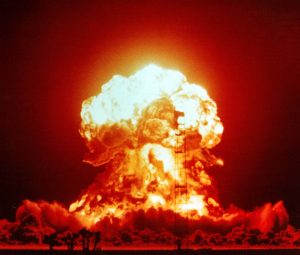Since the end of the Cold War, the United States has been a leader of nuclear disarmament efforts. It gradually reduced its nuclear weapons stockpile through a series of arms reduction treaties with Russia. In 2009, then-President Barack Obama also affirmed “America’s commitment to seek the peace and security of a world without nuclear weapons.”
However, the United States still has an inexplicably large number of nuclear weapons. It maintains an arsenal of 1,393 strategic warheads deployed on 660 intercontinental ballistic missiles (ICBMs), 240 Trident II D5 submarine-launched ballistic missiles (SLBMs), 20 of which are on 12 Ohio-class submarines, and air-launched cruise missiles (ALCMs) equipped on 18 B-2 Spirit stealth bombers and 76 B-52H bombers.
In addition, contrary to global disarmament efforts, the United States recently began modernizing its nuclear arsenal. The Department of Defense (DOD) seeks to maintain and upgrade the country’s aging nuclear triad – IBCMs, SLBMs, and strategic bombers. The Congressional Budget Office (CBO) estimates the current modernization plans for U.S. nuclear forces would cost $400 billion between FY 2017 and FY 2026.
The Trump administration’s nuclear posture review is yet to be published (though a draft leaked earlier this month). However, it is hard to imagine his administration will discontinue this modernization effort. During the presidential campaign, Donald Trump repeatedly expressed his frustration about the “very terrible shape” of the country’s nuclear arsenal. He also has said he is preparing to have the arsenal in “tip-top shape,” though he denied reports that he wants a tenfold increase in the nuclear arsenal
This modernization effort not only undermines global disarmament efforts but also will force China to reevaluate its nuclear doctrine and reinvigorate its nuclear arsenal in order to maintain deterrence against the United States. China’s response could pose a serious threat to global disarmament efforts, U.S. national security, and regional stability in the Asia-Pacific.
China maintains its nuclear arsenal to guarantee the Communist Party’s stability and survival in the face of external threats, particularly from the United States. Deterrence and self-defense are pillars of the country’s nuclear doctrine. Though China keeps a relatively small nuclear arsenal (around 260 nuclear weapons), its powerful second-strike capability, such as road-mobile solid-fueled ballistic missiles and the “Underground Great Wall,” deters the enemy from threatening the Party or the country.
However, the United States’ modernization of its nuclear arsenal is likely to make China rethink its relatively small nuclear arsenal and defensive-oriented nuclear doctrine. More capable nuclear weapons and delivery systems in the United States will undermine China’s deterrence and self-defense capability. If the U.S. modernization effort continues, then China is likely to react as follows:
First, China could renounce its “no first use” policy. This change will make conditions for China’s nuclear weapons use ambiguous, deterring the United States from taking drastic military action in the region, such as a pre-emptive strike on North Korea.
Second, China will increase its number of nuclear weapons and diversify its delivery methods, specifically strengthening its mobile launchers and multiple independently targetable re-entry vehicles (MIRVs). Not only will the number of nuclear warheads will grow, but China will develop different delivery methods, which will be more difficult for the United States to detect and defend against.
Third, China will be more assertive in its surrounding territories and waters. As uncertainty around nuclear weapons expands, the Chinese military will expand its anti-access/area denial (A2/AD) capability, including accelerating construction of artificial islands in disputed waters to prevent the United States military from freely patrolling in its vicinity.
All of these changes could result in an unnecessary nuclear arms race and potentially a calamitous conflict in the Asia-Pacific region – an outcome neither party wants.
The United States can avoid this unnecessary rivalry with China by postponing some of its modernization effort. Not all modernization programs are immediately necessary. The current nuclear arsenal is more than capable to protect the country and its allies. The Ohio-class replacement program needs to continue to ensure naval supremacy; however, discontinuing the Long-Range Standoff Cruise Missile (LRSO) Program and Ground-Based Strategic Deterrent (GBSD) Replacement Program is not going to seriously impede the country’s deterrence. Current cruise missiles and Minuteman III ICBMs can still function as viable deterrents.
The United States, then, can negotiate with China in bilateral and multilateral settings to push for nuclear weapons reduction in the Asia-Pacific region. This effort can begin by clearing ambiguity surrounding both countries’ nuclear arsenal and nuclear doctrine in the region. Since the country’s first explosion of a nuclear weapon, China has maintained global nuclear disarmament as one of four pillars of its nuclear doctrine. It is in both countries’ interest to maintain relative parity of military power and a stable security environment by arriving at an agreement that discourages the expansion and modernization of nuclear arsenals.
Dr. Martin Luther King once said, “The best way to solve any problem is to remove its cause.” Both countries can eliminate the possibility of a nuclear arms race and maintain stability in the Asia-Pacific region by taking one small step toward restricting the size and quality of their nuclear arsenals.
Kim Mu Kwan (Harry) is an MA candidate in Global Policy Studies at the University of Texas at Austin. He is currently a Brumley Next Generation Graduate Fellow in the Robert Strauss Center for International Security and Law’s Understanding China Program.

































